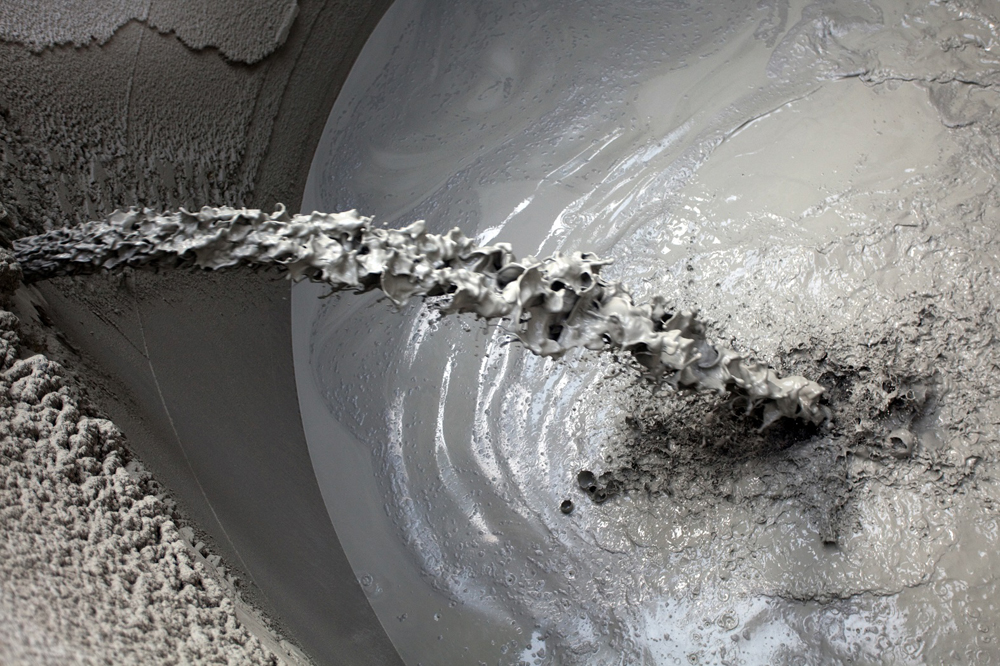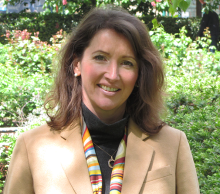
A passion for sustainability has been at the core of Dinah McLeod’s professional career to date, so the recent appointment of the dual British-Canadian national as chief executive of the Global Cement & Concrete Association (GCCA) looks a wise decision.
Most recently a director of ‘The B Team’, an innovative and standard-setting non-profit initiative which was established to improve business practices to enhance the well-being of people and the planet, McLeod has also held senior sustainability roles with the Overseas Development Institute, the UK’s largest development research institute, and in the private sector with BT, Novartis and Allianz. She has succeeded Australian national Benjamin Sporton, a former chief executive of the World Coal Association, who had served as GCCA chief executive since its formation in 2018.

“I’m a newcomer to this industry, but I come from a sustainability background. The thing about sustainability people is that they like having an impact. What really excites us is getting the chance to really make a difference. The role of business in achieving global sustainability is my passion. The concrete industry is an emitter of climate impacting emissions – it recognises this. That said, these materials are so crucial to the world. You cannot imagine fulfilling sustainable development goals without cement and concrete at the heart of it. So, the idea of coming to an industry association that represents major companies that are really serious about sustainability and driving down those emissions is very exciting.
“The GCCA itself is also the Best in Class – with a sustainability charter, report measuring, and guidelines on sustainability that members have to abide by.”
Led by the world’s top 40 international cement companies, the GCCA is dedicated to developing and strengthening the sector’s vital contribution to sustainable construction. The association also fosters innovation throughout the construction value chain in collaboration with industry associations, architects, engineers and corporate innovators.
GCCA member companies make up 40% of global cement production. Having secured all the big industry players, including LafargeHolcim, CEMEX, HeidelbergCement, CRH, Buzzi UNICEM, Dalmia Cement, Titan Cement, Vicat and Votorantim, the GCCA is now looking to work more closely with medium- and ambitious small-sized sector companies.
“The concrete industry is very well known but often misunderstood. Once you start finding out that after water, concrete is the most used material on earth, that all our community infrastructure is made of it, you become obsessed by it. My role is talking to the outside community about the importance of our industry to the world while also ensuring global sustainability.”
In September, the GCCA launched a joint industry ‘2050 Climate Ambition’ with an aspiration to deliver to society carbon-neutral concrete by 2050. The ambition statement identifies the essential levers that will be required for achieving carbon-neutral concrete: reducing and eliminating energy-related emissions; reducing process emissions through new technologies and deployment of carbon capture, more efficient use of concrete; reuse and recycling of concrete buildings; and harnessing concrete’s ability to absorb and store carbon from the atmosphere.

GCCA member companies are currently developing a 2050 concrete roadmap which will set out the detailed actions and milestones that the industry will enact to achieve its ambition. The roadmap is due to be completed towards the end of next year. The 2050 Climate Ambition builds on the longtime climate commitments and sustainability progress of GCCA member companies and affiliate associations worldwide.
“I didn’t even have a chance to get my feet under my desk when the GCCA launched a quite incredible 2050 Climate Ambition statement,” says McLeod. “The reception for it has been amazing. We’ve had lots of media interest and got the chance to engage at the very highest levels of policymaking. An example of this is when the GCCA was one of only two private enterprise voices, the other being the president of Microsoft [Brad Smith], invited by the UN secretary-general to join a distinguished panel discussing environmental issues.
“The cement and concrete industry is one of the most competitive industries in the world, yet when the senior people from our member companies meet up on GCCA business, they are very cordial. They just come and talk with each other to advance our important work. But I have seen the competitive edge at times in practice when it came to sustainability, but that is great, channelling a rivalry to encourage progress
“The concrete industry is also conservative. When the leaders running our member companies commit to supplying carbon-neutral concrete by 2050, it’s more than just words. They won’t commit to something they don’t think can be delivered.”
While the COVID-19 pandemic has limited her ability to get out on GCCA-member company work sites and travel for face-to-face dialogue with senior member company executives, McLeod has been drawing on the “world-class” expertise of GCCA’s senior management team as she settles into her chief executive role. “I’ve learned an enormous amount from our vastly experienced GCCA team, and there are experts among our member companies who have been very generous with their time. I have also been very bookish in my reading about the industry, and I look forward to getting out on site as soon as possible.”

September’s big 2050 Climate Ambition statement launch was followed on 6-7 October by the GCCA Annual Conference, staged virtually due to the COVID-19 pandemic.
Around 500 senior executives, including cement and concrete industry CEOs, experts and vital global stakeholders gathered online for what was the association’s third annual conference, staged under the central theme of ‘building the sustainable world of tomorrow’.
Moderated by renowned broadcaster Gavin Esler, the conference featured a keynote presentation from Dr. Timur Gül, head, Energy Technology Policy Division of the International Energy Agency on industry transition to a low-carbon future. Other key contributors over the two days included Pratima Rangarajan, chief executive of OGCI (Oil & Gas Climate Initiative) & Climate Investments, and high-level stakeholder organisations including WeMeanBusiness, and the IUCN Global Business and Biodiversity Programme, as well as cement and concrete industry CEOs.
Delegates also discussed health and safety, best practices and reporting, thought leadership and resilience, and the role of innovation in building a more sustainable future world.
“The GCCA did something extraordinary. We held a major conference fully online, and it felt quite natural. It was great to have Gavin Esler moderating, and there was a nice mix of technology and humans in a TV studio and online.
“Because of the unique circumstances we find ourselves in, we were able to broaden the conference’s audience beyond our working groups. We’ve got our key 2050 Climate Ambition statement, and the conference was a key opportunity to continue the dialogue over how we get there.”
McLeod notes the particular importance of health and safety in the modern cement and concrete industry, citing conversations on the subject with Albert Manifold, GCCA president and chief executive of Irish building materials giant CRH. “Albert has repeatedly said to me that COVID-19 has put a spotlight on health and safety. He said, ‘Focus everything on this issue. The health and safety of our employees, our facilities and interactions with the wider world are of number one importance to our industry’. It’s been great to hear the stories of people in our industry also downing tools and helping in their local communities.

“Like in other industries, COVID-19 has had a significant effect on the cement and concrete industry. Because of the industry we have, we see a bounce back. Construction is 13% of the world’s GDP (gross domestic product). Construction is also going to be one of the tools to help us emerge out of this dreadful pandemic and build towards a recovery. This is an industry which will play such an important role over the long-term.”
Created by GCCA and launched at the association’s annual conference in Singapore in October 2019, Innovandi – the Global Cement and Concrete Research Network – staged in June 2020 its initial ‘Kick-off Week’ of online workshops, aimed at accelerating global collaboration on cement and concrete research.
The week brought together 40 scientific institutions from across the world and 30 leading industry players from across the cement and concrete sector, including cement and concrete manufacturers, concrete admixture specialists and equipment suppliers. Over the week, the Innovandi industrial and academic partners set headline themes for future research projects to improve sustainability and decrease CO₂ emissions.
“We are looking to continue to grow Innovandi and we welcome companies from the supply chain to also join us on this important mission,” stresses McLeod.
Innovandi aims to build on the cement and concrete industry’s progress to date, which includes achieving a 19.2% reduction in CO₂ per tonne of cementitious product since 1990. Additionally, the proportion of alternative fuels used is now 9.5 times greater than in 1990.
“The GCCA’s role, through Innovandi and other platforms, is to facilitate information transfer. We are not talking about getting companies to share their industrial secrets. We want a policy framework where this playground for innovation allows and facilitates more research and development. For example, can Innovandi help develop carbon-capture technology and access research funding? It’s more about providing a home for everyone that is doing research. We need bright new engineers to come into our industry and create technology that enables us to go forward.”

Originally from Vancouver, Canada, McLeod, who is married and a mother of two teenage children, has lived and worked in London for many years. She holds a master’s degree in Public Administration from Princeton University’s Woodrow Wilson School as well as a BA (Hons) from Columbia University. She began her career as a social protection specialist at the World Bank, where she worked on community-based financing and social infrastructure projects for marginalised and vulnerable groups. She was also a policy advisor at the UK Prime Minister’s Strategy Unit.
Expanding on her key role as GCCA chief executive, McLeod continues: “What I see as one of my fundamental roles is to say to governments and international public policymakers that we need partnerships at every level, municipal and global, so we can achieve our very challenging ambition. We need to invest in carbon-capture technologies, in policies that promote the circular economy and go on highlighting the importance of the cement and concrete industry in global climate resilience.
“People won’t have decent homes and schools without concrete. It’s been a fundamental building block for thousands of years. There are simply no alternatives at scale with anything like the performance benefits of concrete, nor need there be. It allows us to build at a cost that is sustainable and at a carbon point that we are committed to driving right down.”
Global sustainability will be at the forefront of delegates’ minds at next year’s United Nations Climate Change Conference, also known as COP26, being held in Glasgow, Scotland, from 1 to 12 November 2021 under the presidency of the UK government, with assistance from the Scottish government. McLeod and her GCCA team are talking to government figures about how its work and 2050 Climate Action statement can feed into the global showpiece event.
The GCCA’s new chief executive can always count on a great deal of domestic support for her sustainability work from her husband, who is an astrophysicist, and her teenage children. “Teenagers tend to have a very sophisticated view of sustainability, led by environmental concern.”
A highly enjoyable hour’s conversation with McLeod has covered much ground. Achieving global sustainability is an almighty challenge, but one she, her team and her GCCA-member company colleagues are very much signed up to and determined to deliver.









